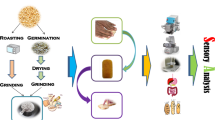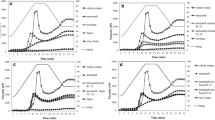Abstract
The addition of sprouted grains and seeds to cereal products has been identified as one of the upcoming trends in recent market reports. In this study, seven types of sprouts (amaranth, brown millet, corn, lentil, lupin, pea, quinoa) were milled and characterised with respect to their compositional (starch, protein, fat, ash, fibre, moisture) and functional properties (water hydration properties). These sprouted flours were included in a gluten-free bread formulation at a level of 5% and the impact on dough (temperature-dependent rising behaviour, pasting and rheological properties) and bread quality parameters (volume, crumb structure and texture) was evaluated. Factors such as the method of germination and the botanical origin influenced the chemical composition of the applied raw material. The functional properties of the different malts and sprouts are affected by the chemical composition of the individual grains. The differences in functional properties were, in turn, found to affect the dough properties and the quality parameters of the baked gluten-free breads. However, statistical analysis showed no correlation between the various factors. Based on this, effects on dough and bread properties were hypothesised to be caused by a combination of multiple factors. All bread formulations containing sprouted flour had significantly improved bread quality parameters in comparison to the control (without sprouted flour). The addition of amaranth sprouted flour, however, resulted in the highest loaf volume and the softest breadcrumb, suggesting its potential for further investigations in further studies.



Similar content being viewed by others
References
Online-Source:, The Washington Post: plant proteins, healthy fats and more 2017 Food Trends. Date Accessed 21 May 2018
Hübner F, Arendt EK (2013) Germination of cereal grains as a way to improve the nutritional value: a review. Crit Rev Food Sci Nutr. 53(8):853–861
Omary MB et al (2012) Effects of germination on the nutritional profile of gluten-free cereals and pseudocereals: a review. Cereal Chem. 89(1):1–14
Deora NS, Deswal A, Mishra HN (2014) Alternative approaches towards gluten-free dough development: recent trends. Food Eng Rev. 6(3):89–104
Lionetti E et al (2015) Celiac disease from a global perspective. Best Pract Res Clin Gastroenterol. 29(3):365–379
Foschia M et al (2016) Nutritional therapy–facing the gap between coeliac disease and gluten-free food. Int J Food Microbiol. 239:113–124
Mäkinen OE, Zannini E, Arendt EK (2013) Germination of oat and quinoa and evaluation of the malts as gluten free baking ingredients. Plant Foods Human Nutr. 68(1):90–95
Phattanakulkaewmorie N, Paseephol T, Moongngarm A, (2011) Chemical compositions and physico-chemical properties of malted sorghum flour and characteristics of gluten free bread. World Acad Sci Eng Technol. 5(7): p. 532–538
Cornejo F, Rosell CM (2015) Influence of germination time of brown rice in relation to flour and gluten free bread quality. J Food Sci Technol. 52(10):6591–6598
Cornejo F et al (2015) Effects of germination on the nutritive value and bioactive compounds of brown rice breads. Food Chem. 173:298–304
Chauhan A, Saxena D, Singh S (2015) Total dietary fibre and antioxidant activity of gluten free cookies made from raw and germinated amaranth (Amaranthus spp.) flour. LWT Food Sci Technol. 63(2):939–945
Brijs K et al (2002) Proteolytic enzymes in germinating rye grains. Cereal Chem. 79(3):423–428
Horstmann SW, Atzler JJ, Heitmann M, Zannini E, Arendt EK (2018) Fundamental study on the impact of different S. cerevisiae yeast strains on gluten-free dough and bread quality parameters. Eur Food Res Technol 1–11
Kunze W (1999) Malt production. Technology brewing and malting. VLB, Berlin, pp 88–170
Randez-Gil F, Sanz P, Prieto JA (1999) Engineering baker’s yeast: room for improvement. Trends Biotechnol. 17(6):237–244
Sujak A, Kotlarz A, Strobel W (2006) Compositional and nutritional evaluation of several lupin seeds. Food Chem. 98(4):711–719
Hager A-S et al (2012) Nutritional properties and ultra-structure of commercial gluten free flours from different botanical sources compared to wheat flours. J Cereal Sci. 56(2):239–247
Sluimer P (2005) Principles of breadmaking: functionality of raw materials and process steps. American Association of Cereal Chemists, St. Paul, MN
Copeland L et al (2009) Form and functionality of starch. Food hydrocoll. 23(6):1527–1534
Gallagher E (2009) Gluten-free food science and technology. John Wiley & Sons, Hoboken, New Jersey
Horstmann SW et al (2016) Fundamental study on the impact of gluten-free starches on the quality of gluten-free model breads. Foods. 5(2):30
Mäkinen OE, Arendt EK (2015) Nonbrewing applications of malted cereals, pseudocereals, and legumes: a review. J Am Soc Brew Chem. 73:223–227
Rosell CM, Enzymatic manipulation of gluten-free breads. Gluten Free Food Sci Technol. 2009: p. 83–98
Renzetti S, Arendt E (2009) Effect of protease treatment on the baking quality of brown rice bread: From textural and rheological properties to biochemistry and microstructure. J Cereal Sci. 50(1):22–28
Haros M, Rosell CM, Benedito C (2002) Effect of different carbohydrases on fresh bread texture and bread staling. Eur Food Res Technol. 215(5):425–430
Giannone V et al (2016) A novel α-amylase-lipase formulation as anti-staling agent in durum wheat bread. LWT Food Sci Technol. 65:381–389
Wang J, Rosell CM, de Barber CB (2002) Effect of the addition of different fibres on wheat dough performance and bread quality. Food Chem. 79(2):221–226
Horstmann SW, Axel C, Arendt EK (2018) Water absorption as a prediction tool for the application of hydrocolloids in potato starch-based bread. Food Hydrocoll. 81:129–138
Rosell C, Rojas J, De Barber CB (2001) Influence of hydrocolloids on dough rheology and bread quality. Food Hydrocoll. 15(1):75–81
Horstmann S, Foschia M, Arendt E (2017) Correlation analysis of protein quality characteristics with gluten-free bread properties. Food Funct. 8(7):2465–2474
Schirmer M, Jekle M, Becker T (2015) Starch gelatinization and its complexity for analysis. Starch-Stärke. 67(1–2):30–41
Rojas J, Rosell C, De Barber CB (1999) Pasting properties of different wheat flour-hydrocolloid systems. Food Hydrocoll. 13(1):27–33
Chanapamokkhot H, Thongngam M (2007) The chemical and physico-chemical properties of sorghum starch and flour. Kasetsart J Nat Sci. 41:343–349
Poutanen K, Enzymes (1997) An important tool in the improvement of the quality of cereal foods. Trends Food Sci Technol. 8(9):300–306
Capriles VD, Arêas JAG (2014) Novel Approaches in Gluten-Free Breadmaking: Interface between Food Science, Nutrition, and Health. Compr Rev Food Sci Food Saf. 13(5):871–890
Ziobro R et al (2013) Supplementation of gluten-free bread with non-gluten proteins. Effect on dough rheological properties and bread characteristic. Food Hydrocoll. 32(2):213–220
Witczak M et al (2012) Influence of modified starches on properties of gluten-free dough and bread. Part I: Rheological and thermal properties of gluten-free dough. Food Hydrocoll. 28(2):353–360
Pruska-Kędzior A et al (2008) Comparison of rheological, fermentative and baking properties of gluten-free dough formulations. Eur Food Res Technol. 227(5):1523
Morris GA et al. (2008) Global hydrodynamic analysis of the molecular flexibility of galactomannans. Carbohyd Polym. 72(2): 356–360
BeMiller JN, Whistler RL (2009) Starch: chemistry and technology. Academic Press, Cambridge, Massachusetts
BeMiller JN, Pasting, paste, and gel properties of starch–hydrocolloid combinations. Carbohyd Polym. 2011. 86(2): 386–423
Fadda C et al. (2014) Bread staling: updating the view. Compr Rev Food Sci Food Saf. 13(4): 473–492
Cauvain SP, Young LS (2016) Technology of breadmaking. Springer, Berlin
Primo-Martín C, Hamer RJ, de Jongh HH, Surface layer properties of dough liquor components: are they key parameters in gas retention in bread dough? Food Biophys. 2006. 1(2): 83–93
Nunes MHB et al. Impact of emulsifiers on the quality and rheological properties of gluten-free breads and batters. Eur Food Res Technol. 2009. 228(4): 633–642
Matos ME, Rosell CM (2012) Relationship between instrumental parameters and sensory characteristics in gluten-free breads. Eur Food Res Technol. 235(1): 107–117
Acknowledgements
The authors want to thank Tom Hannon for his technical support. The work for this study was part of the PROTEIN2FOOD project. This project has received funding from the European Union’s Horizon 2020 research and innovation programme under grant agreement No. 635727.
Author information
Authors and Affiliations
Corresponding author
Ethics declarations
Conflict of interest
The authors declare that they have no competing interest.
Ethical approval
This article does not contain any studies with human or animal subjects.
Rights and permissions
About this article
Cite this article
Horstmann, S.W., Atzler, J.J., Heitmann, M. et al. A comparative study of gluten-free sprouts in the gluten-free bread-making process. Eur Food Res Technol 245, 617–629 (2019). https://doi.org/10.1007/s00217-018-3185-2
Received:
Revised:
Accepted:
Published:
Issue Date:
DOI: https://doi.org/10.1007/s00217-018-3185-2




